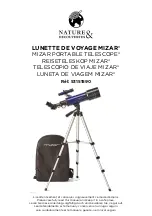
8
Observing Tips:
Star hopping
Star hopping is a technique used by amateur astronomers to navigate the night sky. By using easily
recognizable constellations and asterisms as a guide, an observer can locate stars and other objects.
For example, Polaris, which is commonly referred to as The North Star, can be located quickly using
star hopping. First, find the Big Dipper asterism in the Ursa Major constellation. The popular pattern is
defined by seven stars, and the two stars on the front edge of the Big Dipper’s “bowl” are Merak and
Dubhe. Next, draw an imaginary line from the bottom star (Merak) on this front edge through the top
star (Dubhe) on the front edge. Follow the line to the first bright star you see. That should be Polaris.
Finally, to verify your finding, locate the Little Dipper asterism. Polaris is the anchor star at the end of
the Little Dipper’s “handle.”
Image credit: Howard Eskildsen
Note: Images are for illustration purposes only. Quality of your image may very depending upon atmospheric conditions and location.
Possible Objects for Observation:
What you can observe at any one time in your telescope
depends on several factors beyond aperture and magnification.
These factors include location, date, time and sky conditions.
The following are all objects that can be seen with the unaided
eye and/or binoculars. Your telescope can enhance views of any
of these objects if the observing conditions are right.
The Moon:
Diameter:
3,476 km
Distance:
Approximately 384,401 km
The Moon is the Earth’s only natural satellite, and it is the
second brightest object in the sky (after the Sun). Although it
is our closest neighbor, a lot of people have never really taken
a good long like at the Moon. With your telescope, you should
be able to see several interesting lunar features. These include
lunar maria, which appear as vast plains, and some of the larger
craters. The best views will be found along the terminator, which
is the edge where the visible and shadowed portions of the
Moon meet.
BIG DIPPER
LITTLE DIPPER
POLAR STAR
CASSIOPEIA
Caph
Zeta
Beta
Kochab
Pherkad
Gamma
Eta
Epsilon
Delta
Alpha
Shedar
Cih
Ksora
Segin
Alkaid
Alcor
Mizar
Alioth
Megrez
Phecda
Merak
Dubhe
Note: The positioning of the Big Dipper in relation to the Little Dipper does not change, but the
orientation of both in the night sky will rotate throughout the year due to the motion of the Earth.
Summary of Contents for STAR50APP
Page 15: ...15 Notes ...


























